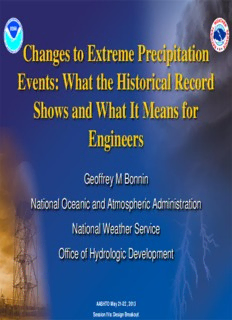
Updating NOAA Rainfall Frequency Atlases - AASHTO PDF
Preview Updating NOAA Rainfall Frequency Atlases - AASHTO
Changes to Extreme Precipitation Events: What the Historical Record Shows and What It Means for Engineers Geoffrey M Bonnin National Oceanic and Atmospheric Administration National Weather Service Office of Hydrologic Development AASHTO May 21-22 , 2013 Session IVa: Design Breakout Topics • Brief introduction to NOAA Atlas 14 • How it is used by engineers • Ongoing efforts to update the Atlas • Improvements that these updates contain • Potential Impact of Climate Change on Precip Frequency • The semantic problem • Exceedances • Climate Change and PMP NOAA Atlas 14: Precipitation Frequency Atlas of the United States • National design standard for infrastructure built to cope with rainfall and runoff – Construction: • storm water drainage systems, roads, bridges, culverts, small dams, detention basins, airport runways – Ecosystems: • in-stream ecosystems including fish habitat, stream erosion control, pollution control systems, soil conservation – Other: • flood insurance rate maps, flood plain management • Ensure objective assessment of the probability of heavy rainfall in planning and design NOAA Atlas 14 Summary • Begun in 2000 • Published as volumes by project are a – as funds become available • Annual Exceedance Probability: 1/2 – 1/1,000 • Durations: 5 minutes – 60 days • Error Estimates: 90% confidence intervals • Locally Relevant: 30 arc-sec resolution • User Friendly: web based, interactive NOAA Atlas 14 Status Sources of Change • Much more data (examples from Volumes 8 & 9) – 1,850 daily stations • 360 stations in TP49 (1964) for all CONUS – Average Record Length 70 Years • Rejected daily stations with <~50 years • TP49 average record length ~20 years • New Statistical Techniques – L-Moments replaces conventional moments – Regional approach vs at site • Trading space for time increases effective record length • Objective methods of Spatial Interpolation – Observations in mountains • interpolation vs extrapolation Potential Impact of Climate Change “Management and mission-oriented agencies with public-sector responsibilities have been provided with marginally useful scientific information about the likely manifestations of future climate change.” “There are insufficient interactions and knowledge exchange between climate scientists, water scientists, and engineers and practitioners to solve these challenges.” “Global Change and Extreme Hydrology: Testing Conventional Wisdom” National Research Council, Water Science and Technology Board, 2011 Climatology Semantics • “It is likely that the frequency of heavy precipitation events … has increased over most areas.” – IPCC AR4, Climate Change 2007: Synthesis Report • “Groisman et al. (2005) found significant increases in the frequency of heavy and very heavy (between the 95th and 99.7th percentile of daily precipitation events)” – IPCC AR4 Working Group I • These and similar statements in the literature define terms such as – “heavy”, “very heavy”, or “extreme”precipitation – Sometimes differently! For Example • Groisman et al 2005 – “… we define a daily precipitation event as heavy when it falls into the upper 10% and/or 5% of all precipitation events; as very heavy when it falls into the upper 1% and/or 0.3% of precipitation events; and extreme when it falls into the upper 0.1% of all precipitation events.” – “The return period for such events … varies, for example, from 3 to 5 yr for … very heavy precipitation events.” • Generally consider just daily durations Civil Engineering Semantics • Use precipitation frequency estimates – average annual exceedance probabilities (AEP) or – average recurrence intervals (ARI) • Heavy, very heavy, and extreme rainfall: – generally subjective terms • Use many durations; not just daily – NOAA Atlas 14 provides 5 min through 60 days
Description: